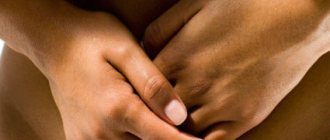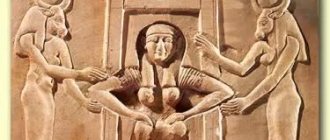“You will give birth to your children in pain,” it was once said to Eve, expelled from paradise. Fear of terrible pain during childbirth is one of the reasons why many women are in no hurry to have children. However, modern obstetrics provides a choice: you can give birth in pain, or without it. But won’t pain relief disrupt the natural processes in the bodies of a woman in labor or a baby? It turns out that maternal instinct is closely related to painful sensations during childbirth. At least for deer. Swiss scientists conducted an experiment: they gave anesthesia to twenty pregnant deer. All the females gave birth safely to healthy cubs, but none of them licked the newborn, and most of them generally abandoned their offspring. It would seem that no pain means no problems. However, doctors assure that pain is necessary: it is she who forces a woman to complete the process of childbirth, that is, to strive for its end - the birth of a baby. No pain, no desire to work. But childbirth is exactly work. On the other hand, everyone’s pain sensitivity threshold is different. Some people don’t feel pain at all, while others literally climb up the wall from it. Under the influence of “uncontrollable” pain, a woman in labor may have an increase in blood pressure, an increase in heart rate, and, therefore, an increase in the load on the heart. This is harmful to the health of mother and child.
The nature of labor pain
During contractions in the first stage of labor, irritation of the nerve endings of the body and cervix, blood vessels and ligaments occurs. In the second stage of labor - expulsion of the fetus - the nerve endings of the perineum and external genitalia are predominantly irritated. Both those and other impulses, entering the central nervous system, are normally blocked and are not perceived as pain signals, that is, they remain below the pain threshold. In addition, there are additional factors. Firstly, before childbirth, partial destruction of the nerve endings of the uterus occurs, and therefore its sensitivity decreases in comparison with the 1st and 2nd trimesters of pregnancy. And secondly, during childbirth, a powerful release of endorphins and enkephalins occurs in the body - “pleasure hormones”, natural painkillers, related in structure to narcotic analgesics.
But women from generation to generation indulge in the fear of birth pangs, recorded in the pages of the Old Testament. This fear has a real historical basis. After all, hundreds of years ago, in the absence of adequate obstetric care, many births were indeed very difficult, with dangerous complications and often ended in the death of the woman in labor. The fear of inevitable pain during childbirth disrupts the harmony of relationships in the structures of the brain, sharply reducing the pain threshold, and therefore those painful stimuli that normally should not penetrate our consciousness begin to be perceived. This is the so-called psychogenic component of labor pain. As a result of the passage of pain impulses through the central nervous system, reflected pain occurs on the surface of the body: in the lower abdomen, in the lumbosacral region, in the upper third of the thighs and in the groin.
I'm tired of pregnancy. How to give birth faster?
It's no secret that pregnancy is a very tiring period for a woman. Plus, it is accompanied by frequent mood swings, often poor health, insomnia, increased fatigue and irritability. Often women dream of seeing their baby as soon as possible at 39 weeks. “How to give birth faster?” - this question becomes the main one for every second representative of the fair sex. The fact that labor can be induced at home is not a myth. This is true. However, how to do this?
Firstly, this can be achieved through banal sex. The essence of this method is that at the moment when a woman reaches orgasm, the uterus becomes toned, which can trigger the onset of labor.
Secondly, it is necessary to note such a method as nipple stimulation. How this will happen - with the lips of a partner or with the help of fingers - is essentially not so important. In addition, this method brings double benefits: on the one hand, it can provoke contractions, and on the other, it improves the shape of the nipples, which will come in handy when breastfeeding.
Thirdly, it should be emphasized the effectiveness of such simple methods of stimulating labor as fast walking, heavy physical activity, the use of homeopathic and herbal remedies, and eating a number of foods, such as pineapples.
At the end of pregnancy, a woman’s desire to give birth as quickly as possible is understandable, because it simply becomes physically difficult for her. However, this in no way indicates that the child is ready to be born. Based on this, it should be taken into account that in order to avoid further complications and the birth of an immature baby, you should not rush, but rather be patient and wait a little longer.
Pain during childbirth. Down with the psychogenic factor!
What is the opposite of fear? Waiting for the holiday. Do you remember how, as a child, you were waiting for your next birthday or New Year, how your heart skipped a beat in anticipation of fun and gifts? And how joyful it must be to expect a miracle, great happiness - a meeting with the most beloved and most beautiful person whom you will give to the world! Dreams come true, new facets of love, a new phase of merging with your loved one. I want to bring the sweet moment closer and, having plunged, drink it entirely, to the dregs. Dream about contractions, remember that pain can sometimes be very sweet.
What about women's curiosity? Of course, you’ve read and heard a lot about this, but it’s incredibly interesting to experience everything yourself, I wonder how it will happen to you. Moreover, even repeated births are not similar to the previous ones.
In addition, childbirth is perhaps the only work and pleasure that is not available to a man. And although many future dads now strive to be present at the birth of their child, they still cannot feel it like a woman, because seeing and feeling are not the same thing.
Sometimes women want to go to the maternity hospital a few days before giving birth. This is not always justified. No maternity hospital, even the best one, can replace the warmth and comfort of your home. If the pregnancy proceeds without complications and there are no indications for prenatal hospitalization, it is better to spend the last days before childbirth surrounded by loved ones, and not in the department of pathology of pregnant women, where you will inevitably be haunted by the burden of other people’s problems. It happens that a woman herself, going to the maternity hospital, cannot accurately determine whether she has begun labor. If, in this case, the doctor who examined you in the emergency department states that this is only a harbinger of labor and invites you to return home, listen to his advice. The maternity ward is a place where you need to give birth, and not languish, empathizing with others.
What is childbirth?
Before asking yourself how to give birth quickly, you first need to know what childbirth is. In simple terms, we can say that they represent a natural physiological process that ends the pregnancy period. As a result, the long-awaited baby is born, and the so-called afterbirth is expelled from the body. But at what stage of pregnancy should you expect this exciting moment and the first long-awaited meeting with your child?
Doctors say that a pregnancy is considered full-term at exactly 37 weeks, that is, 259 days, which begin to count from the first day of the last menstruation. From this moment until the 42nd week (293 days), birth can occur at any time. If they occur before the 37th week, they are considered premature, and the baby is considered premature. If the baby is in the womb for more than 42 weeks, it is called post-term, and the birth is called late.
Self-anesthesia of childbirth: techniques and methods
The first stage of labor - the period of cervical dilatation - is the longest: 10-11 hours for primiparous women and 6-9 hours for multiparous women. Usually it is the most painful and difficult for a woman. But in the first period, the expectant mother does not require active physical effort to develop labor, since contractions occur involuntarily and cannot be controlled at will. In the absence of contraindications and with the permission of the doctor leading the birth, the woman in labor can choose for herself the position and style of behavior that is most comfortable for her and relieves pain as much as possible: the main task during labor is to help herself. No one currently requires a woman to lie still during childbirth; natural behavior - that which nature itself suggests to her - is considered the most physiological.
Most women endure contractions more easily in an upright position: some prefer to walk, others stand, squat, or lean on the back of the bed. In addition to the analgesic effect, active behavior during childbirth is also welcomed because it creates the most optimal conditions for the advancement of the fetus along the birth canal and improves uterine contractility, preventing weakness of labor. The vertical position does not interfere with monitoring the condition of the mother and fetus (for example, cardiotocography) and, if necessary, intravenous drip administration of drugs through a plastic catheter.
If a woman feels more comfortable lying down, the side position is preferable. Lying on your back during pregnancy and childbirth is not recommended, as in this case the uterus compresses the inferior vena cava, limiting blood flow to the heart. As a result, blood flow in the kidneys, uterus and placenta is disrupted, blood pressure may decrease, dizziness and loss of consciousness may develop.
During childbirth, it is very important to learn to think only about the current contraction, without fantasizing about whether it will hurt even more and how long it will last. Don’t needlessly torment yourself with questions to which no one can give an accurate answer. It is better to count during a contraction to determine its duration. First, the score itself will distract you; secondly, you will have information useful to your doctor; thirdly, you will be pleasantly surprised that contractions are much shorter than you thought before.
The breaks between contractions should be used for rest, both moral and physical. By the way, it is useful to take a nap during childbirth, especially while the contractions are not bothering you too much. Save your strength, you will still need it.
Massage or self-massage plays an important role in pain relief during labor. Touch stimulates skin receptors, which in turn send many impulses to the mount of the brain. These impulses, spreading more quickly, successfully compete with pain signals and thus reduce pain.
Here are the simplest but most effective self-massage techniques used during contractions.
- Stroking the lower half of the abdomen . Place both palms on the stomach above the pubis and lightly stroke with your fingertips from the center to the sides of the abdomen and upward.
- Stroking the skin in the lumbosacral region . It can be carried out with both palms and fists. It can be more intense than stroking the belly.
- Pressing the skin at the lateral corners of the sacral rhombus . The lateral angles correspond to the posterosuperior spines of the iliac bones, and are contoured on the skin in the form of two small dimples located above the intergluteal fold symmetrically on both sides. For an analgesic effect, apply pressure to the skin in this area with your fists.
- Pressing the skin against the inner surface of the iliac crests . In the lateral sections of the lower half of the abdomen, it is easy to palpate the protruding bones (anterior superior iliac spines), which are a kind of corners of the pelvic bones. To the sides of them, dense crests of the iliac bones stretch towards the sacrum. You need to place your palms along your thighs with your fingers down, while pressing your thumbs against the inner surface of the anterosuperior spines.
Hydrotherapy—water—has a huge positive effect on the course of labor. In some maternity hospitals, maternity wards are equipped with a bath or shower. Warm baths, like massage, affect the nerve endings of the skin, as a result of which the transmission of pain stimuli to the brain is disrupted. In addition to the analgesic effect, hydrotherapy relieves tension and causes adequate relaxation of the abdominal muscles, as a result of which the oxygen supply to the uterus improves and its contractions become more effective. It should be noted that hydrotherapy in the bath can be used before the amniotic fluid ruptures.
Of course, these standard recommendations can be used for normal, uncomplicated childbirth. But every birth, like every woman and her child, requires an individual approach. Therefore, expectant mothers need to strictly follow the advice of the obstetrician-gynecologist leading the birth.
The second stage of labor is the most difficult for the child, and requires the woman to mobilize all the forces of her body. Perhaps that is why subjective pain sensations recede into the background at this moment. Pain may occur in the area of the external genitalia at the time of eruption of the head. In order to reduce pain, as well as prevent birth trauma to the child and ruptures of the genital organs of the perineum, you just need to listen carefully and strictly follow everything that the doctor and midwife say: push correctly and on time, breathe correctly and suppress pushing when necessary. For example, if it is necessary to perform an episiotomy, the obstetrician-gynecologist asks the woman to push very hard, as this stretches the perineal tissue, thinning it, and the incision is made painlessly.
Signs indicating that labor is around the corner
Naturally, every pregnant woman is concerned about how to give birth quickly and painlessly. However, this is far from the only thing that the expectant mother should worry about. Just before childbirth, there comes a period when the woman’s body prepares for this important moment and foretells that the baby will soon be born. If you are extremely attentive and listen to your feelings, it is impossible not to notice these signs. So, among the signs of impending childbirth, the following should be noted:
- breathing becomes much easier;
- frequent urination and defecation are observed;
- back pain is felt more often and becomes more intense;
— body weight decreases slightly (within 1–2 kg);
— frequent mood swings are observed;
- False contractions appear from time to time.
In primigravidas, as a rule, these signs appear 2-4 weeks before birth. Right now they are especially starting to worry about the question of how to quickly give birth. Multiparous women experience these changes occurring in their body immediately before childbirth.








